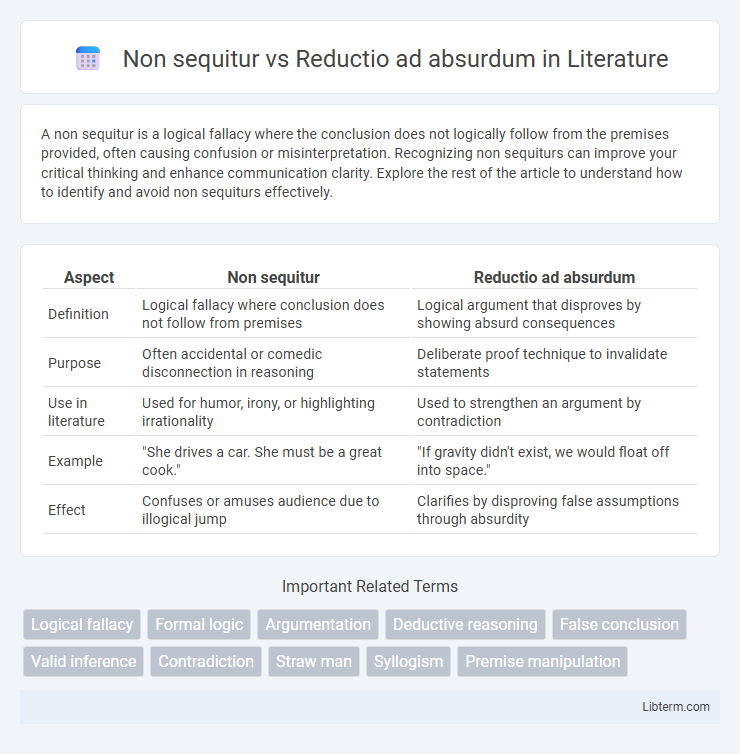A non sequitur is a logical fallacy where the conclusion does not logically follow from the premises provided, often causing confusion or misinterpretation. Recognizing non sequiturs can improve your critical thinking and enhance communication clarity. Explore the rest of the article to understand how to identify and avoid non sequiturs effectively.
Table of Comparison
| Aspect | Non sequitur | Reductio ad absurdum |
|---|---|---|
| Definition | Logical fallacy where conclusion does not follow from premises | Logical argument that disproves by showing absurd consequences |
| Purpose | Often accidental or comedic disconnection in reasoning | Deliberate proof technique to invalidate statements |
| Use in literature | Used for humor, irony, or highlighting irrationality | Used to strengthen an argument by contradiction |
| Example | "She drives a car. She must be a great cook." | "If gravity didn't exist, we would float off into space." |
| Effect | Confuses or amuses audience due to illogical jump | Clarifies by disproving false assumptions through absurdity |
Understanding Non Sequitur: Definition and Examples
Non sequitur is a logical fallacy where the conclusion does not logically follow from the premises, creating a disconnect in reasoning that undermines the argument's validity. Examples include statements like "She drives a car, so she must be wealthy," where the premise about car ownership fails to support the conclusion about wealth. Understanding non sequitur helps identify flawed arguments and improve critical thinking by recognizing when conclusions are unjustifiably drawn.
What is Reductio ad Absurdum? Core Concepts
Reductio ad absurdum is a classical logical technique used to demonstrate the falsity of a proposition by showing that its logical consequence leads to a contradiction or an absurd conclusion. This method relies on assuming the opposite of what needs to be proven and then deriving a statement that conflicts with established facts or logical principles. By exposing the absurdity inherent in the negation, reductio ad absurdum effectively validates the original proposition's truth.
Key Differences Between Non Sequitur and Reductio ad Absurdum
Non sequitur is a logical fallacy where the conclusion does not logically follow from the premises, often leading to illogical or irrelevant results. Reductio ad absurdum is a valid argumentative technique that disproves a proposition by deriving an absurd or contradictory conclusion from it. The key difference lies in non sequitur being a faulty form of reasoning, whereas reductio ad absurdum is a deliberate and structured method to prove a statement false through contradiction.
Common Uses of Non Sequitur in Arguments
Non sequitur, often seen in everyday arguments, occurs when a conclusion does not logically follow from the premises, such as introducing unrelated facts or jumping to unwarranted conclusions. It is commonly used in debates to distract or confuse by presenting irrelevant information that disrupts coherent reasoning. Unlike reductio ad absurdum, which aims to demonstrate the falsity of a premise by deriving a logical contradiction, non sequitur serves as a logical fallacy that weakens argument validity through disconnected or illogical assertions.
Reductio ad Absurdum in Logical Reasoning
Reductio ad absurdum is a powerful logical reasoning technique that refutes a proposition by demonstrating that its logical consequence leads to a contradiction or an absurd outcome, thereby proving the proposition false. It contrasts with a non sequitur, which is a fallacy where the conclusion does not logically follow from the premises, lacking valid inferential connection. Reductio ad absurdum is widely used in mathematics and philosophy to establish the validity of statements through indirect proof by exploring the implications of their negation.
Identifying Non Sequitur Fallacies in Everyday Discourse
Non sequitur fallacies occur when conclusions do not logically follow from their premises, often disrupting coherent communication in everyday discourse. Identifying non sequitur involves recognizing gaps where the argument's conclusion lacks a valid connection to the evidence or reasoning presented. Unlike reductio ad absurdum, which deliberately extends an argument to an absurd conclusion to demonstrate its falsity, non sequitur fallacies arise from unintentional logical disconnects that weaken persuasive discourse.
How Reductio ad Absurdum Strengthens Arguments
Reductio ad absurdum strengthens arguments by demonstrating that denying a proposition leads to a logical contradiction or an absurd outcome, thereby reinforcing the original claim's validity. Unlike a non sequitur, which presents irrelevant or illogical conclusions unrelated to the premises, reductio ad absurdum uses rigorous logical structure to expose the flaws in opposing arguments. This method enhances critical thinking and clarity in debates by systematically eliminating untenable positions.
Non Sequitur vs Reductio ad Absurdum: Misconceptions
Non sequitur and reductio ad absurdum are often confused, but they differ fundamentally in logical structure and intent. Non sequitur refers to a conclusion that does not logically follow from the premises, resulting in a flawed or irrelevant argument. Reductio ad absurdum, by contrast, demonstrates the falsity of a premise by showing that its logical consequence leads to an absurd or contradictory result, serving as a valid argumentative technique rather than a logical fallacy.
Real-World Scenarios: Non Sequitur and Reductio ad Absurdum in Action
Non sequitur occurs when a conclusion does not logically follow from the premises, such as someone claiming a rainy day means a failed project without any direct link. Reductio ad absurdum involves disproving a statement by showing that it leads to an absurd or contradictory conclusion, often used in mathematical proofs or ethical debates to highlight flaws in reasoning. In real-world scenarios, politicians might use non sequitur to distract from issues, while scientists employ reductio ad absurdum to rigorously test hypotheses and strengthen arguments.
Tips to Effectively Use and Spot Logical Devices
Non sequitur involves conclusions that do not logically follow from premises, so carefully examine argument relevance to spot it. Reductio ad absurdum demonstrates a statement's falsehood by showing contradictions or absurd outcomes, effectively used by constructing clear, logical contradictions. To use these devices effectively, ensure your premises align logically in reductio, and watch for leaps in logic or irrelevant conclusions characteristic of non sequitur in others' arguments.
Non sequitur Infographic

 libterm.com
libterm.com